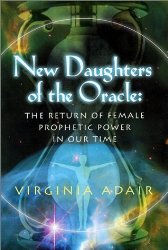
New Daughters of the Oracle: The Return of Female Prophetic Power in Our Time by Virginia Adair
- May 22, 2016
- 0
Review by Eugenia Macer-Story

New Daughters of the Oracle is a personal diary resembling the narrations of Lawrence Durrell in his book Bitter Lemons(1). Although the author conceptualizes herself as documenting the mundane situations and personae of women oracles around the world, everywhere the reflection in Virginia Adair’s perceptions is approximately the same. Is this a study of the oracular women Adair has visited? Or is this a study of Adair herself, a person who by her own account was not as interested in her own “fortune” as in a narration of the fortunes of the many oracular women she has interviewed?
This is a valuable book for any psychical researcher to read, exactly for that obvious, reflective reason. The tradition of “travel books” from which both Adair and Durrell take their style assumes that the traveler will be a peripatetic aristocrat of some sort, either with a retinue or in disguise. Part of the reader’s interest in this tradition of travel literature is the exotic persona of the narrator of the memoir.
In order to write such a memoir, the narrator must assume some arbitrary narrative tone, much as a performer doing a monologue first takes on a dramatic personality. The monologue is not as interesting to read in a flat, non-committal narrative style. Adair is aware of this convention and introduces her narrative voice as “privileged traveler” quite deliberately and successfully. Yet this narrative voice is limited. Any reader will be aware that the many Oracles visited by Adair adapt themselves in their style of advice to her mentally projected expectations as “genteel traveler.” At one point, Adair notices this similarity between interviews she has undertaken with a variety of “Oracles” and wonders why all of the Oracular interviews from all over the world seem so similar.
This is actually an amusing issue which goes far beyond an analysis of the cultural differences between various fortune tellers Adair visited all over the world; for one of the gifts of an actual Oracle is this quality of reflecting the individual destiny and personal rhythms of the querent. Therefore, all the responses of the genuine though culturally diverse Oracles will be somewhat the same or actually identical in basic message. In presenting public communications, one finds that there are a great variety of individual interpretations of the same message. Each receptor will filter the information through his/her own looking glass window. The task then becomes to clear one’s own mechanism before deliberately attempting to use ESP or spirit contact to transmit information.
Again, one of the gifts of an Oracle is this quality of reflecting the individual destiny and rhythm of the querent. So if all of the Oracles consulted during a World Tour are accurate, their many readings will be similar, with variations due to temperament and cultural experience. Yet is the operative function of the practicing Oracle simply to serve the querent? What about the function of the oracular gift in the life of the practitioner herself?
In her excellent book Other Powers(2), author Barbara Goldsmith puts forward the thesis that very real extraordinary abilities in women and oppressed racial and cultural minorities may arise in situations where otherwise there is “no exit” from the given cultural conditions.
Goldsmith’s social and political opinions on spiritualism, different from the opinions of Adair which cite among other factors the accidents of fate and hereditary ability, arise from Goldsmith’s study of extraordinary female personalities who have practiced as “spirit mediums.” It is significant in this context that Goldsmith includes in her study speculations about the sex life of the women she discusses whereas Adair does not take the bait of popular “psychoanalysis” in this regard.
Goldsmith has written a book about the emancipation of women and Adair has written a book about the social and cultural situation of female oracles who had her in to tea internationally. But has either of these authors, who apparently both believe that “psi” or “spiritualism” is merely a side effect of certain material and social situations, studied the “spirit effects” and “psi accuracy” of the people to whom they allude socially as being “exceptional”?
There are thirty-two listings under the category of “spiritualism” in Goldsmith’s book Other Powers. Of these listings, about thirteen relate directly to such issues as “spirit rapping,” sŽances, “mesmerism” and magnetic healing. The rest are ad hominim or historical references. Mind you, there is nothing wrong with this balance of focus. For the history of these “other powers” in women is the avowed subject of Goldsmith’s book. Yet, for the reader simply interested in spiritualism as an activity, Goldsmith’s book does not contain detailed documentary or informative material. In the index listings, I looked up “rapping by spirits.” The body of this book is 447 pages long and there are only three pages listed on “spirit rapping,” an activity which was definitely one of the prominent Victorian and early 20th Century “other powers” of both male and female spirit mediums.
Mention is made in these three pages of the famous Fox Sisters spirit rappings in 1848 in Hydesville, NY. But very shortly afterward this topic is overtaken in the narration by accounts of the link between Quaker inspirational speaking and the Abolitionist movement of the late 19th Century.
In the chapter entitled “The Spiritual Telegraph,” there is a description of a Fox Sisters’ sŽance taken from historical records. But emphasis in Goldsmith’s book is on the social situation wherein these women were forced to strip before a female committee before their “test sŽances,” lest gadgets of trickery be concealed in their clothes. The narration goes on very correctly to link these “Strip the witch!” attitudes to other, similar discriminatory attitudes toward women in the late 19th and early 20th Century. All of this is true and historically relevant(3). But this description of “psychical investigation witch trials” does not enlighten the reader as to what details the spirits might have communicated during these controversial sŽances.
In New Daughters of the Oracle, Adair describes looking for “swan min” or some practitioner of this ancient art of clairvoyant divination, while visiting Taipei, Taiwan. Adair was politely ushered through rooms of traditional artifacts without noticing she had actually learned anything about the inner life of the woman representing this hereditary practice of “swan min.” She remarks in her book that she noticed feeling nothing distinctive personally about the Chinese oracle. Of course, this would be somewhat disappointing for Adair as she was intending to focus on a description of the specific personal characteristics of a variety of female fortunetellers and spirit mediums.
Yet later in her hotel room Adair reports having significant musings about the “mind having it’s own delusions” and the idea that our “conceptions of things come into appearance by the process of the mind itself.” It did not seem to occur to Adair that these significant realizations might indeed be due to the “swan min” of the woman whose exterior appearance she had attempted to describe without paying attention to possible direct effects of this oracular woman’s mind on Adair’s own mental state.
For the actual, traditional Buddhist practitioner may have no specific personal life, as we know “personal life” in Western culture. Books such as The Spirit Rappers by Robert G. Jackson rightly emphasize the physical aspect of the Fox sisters’ “spirit” phenomena, but other aspects of such situations are often overlooked by researchers who are not themselves clairvoyant or the veteran of living in the close vicinity of friends or relatives with genuine “strange talents.”
If the inner life of the spirit mediums is considered at all, it may be described “psychologically” as in Goldsmith’s excellent historical narrative about intelligent women using the trappings of spiritualism to advance themselves rather than more conventional business trappings of the intellectual or political situation which were not available to women. Yet, as “psychical research,” the social discussion of both Adair and Goldsmith is like describing water by giving a close description of a faucet, a glass, a bucket or the human body. All of these physical objects contain water. Yet a description of the container is not a description of the water itself.
A great variety of “container systems” for psychic functioning have been devised in Western culture, ranging from the scholastic mathematical diagrams of the Hermetic philosophers drawn in the Middle Ages to more modern forms of these diagrams in popular books on occult psychology. In the anthology Beyond Reason there is even “an ingenious delineation of the age-old magnetism between male and female in which a clock face is used to chart the 12 libidinal types that attract and repel”(4). Strange as it may seem, these mental systems of description are often more accurate than a rigorous roster of physical, social and political details.
When spirit mediums are limited to describing only the physical aspects of their experiences, they often seem deceptive and, ultimately, like the Fox Sisters of 19th Century Rochester, NY, fail to sustain any convincing spirit manifestations. This is because it is actually deceptive to invoke only physical proofs and demonstrations of allegedly extra-sensory and “spirit” or “non-local” information transfer.
In these investigations, there emerges a difficulty with Adair’s travelogue of lady oracles. She has subtitled her book “the return of female prophetic power in our time,” and yet in descriptions such as of the Turkish psychic “Serna” reading the coffee dregs for the author, Adair sidesteps any specific record of her personal fortunes or their accuracy of prediction. Adair simply states that Serna was “surprisingly accurate” and that it would be “interesting to see if her predictions for my future were also on target.”
Adair questions the thought processes of Serna with thought processes of her own which are heavily influenced by the rationalizations of modern psychology. It did not occur to Adair to muse upon possible inspiration by spirits as part of Serna’s accurate discourse. Yet this possibility seems obvious. All cultural traditions link fortune-telling with spiritism. But in the 20th Century literary tradition, the invocation of “psychological concepts” has become somewhat of a religion. Adair’s book is blessed with many of these “correct” psychological suppositions.
In Plays of the Natural and Supernatural by Theodore Dreiser, written in 1916 before the “psychological religion” was so widely accepted(5), the author, who would later compose the well-known novel Sister Carrie about the social abuses of the then-emerging modern city, assumes that many spirits and forces whisper into the ears of human beings, causing them to be wicked, heedless of ethical and moral responsibility, and to commit crimes. The early Dreiser sees the same grim landscape as he later would depict in Sister Carrie, but in the plays he sees this landscape animated by phantasmagoric forces and creatures. There is even a malevolent spirit form he describes as “the Blue Sphere.” Long before the present day fad for “UFO abductions,” the “blue sphere” of Dreiser’s expressionist play leads a disabled child toward the railroad tracks and an “accidental” suicide.
Toward the end of her book, Adair states: “I am aware that what I have produced here is a mere random sampling, only a handful of interviews with women alleged to be psychic.” Yet I feel this is Adair’s illusion. Adair has, in fact, produced a patterned tapestry of her own impressions, not a random sampling. The “forces” and spirits which formed her adventures and misadventures did not produce a “random sampling.” Rather, Adair’s book is a portrait of a certain level of expectation about female psychics. Adair indicates why she feels that the mental potential of women oracles has been culturally undervalued or overlooked. But she then makes somewhat the same mistake in focusing only on the basic personal situation of these lady oracles, as far as they would reveal this to a traveling stranger, rather than on the actual mental structure and belief systems of their oracular practices.
I look forward to Virginia Adair’s next book and hope this review has been helpful to those who have attempted to study extrasensory perception by limited sensory means.
(1) Lawrence Durrell, Bitter Lemons, Dutton, NY, 1957. (Also the author of Alexandria Quartet, 4 volume work on the control of “objective reality” by a variety of individual viewpoints.)
(2) Barbara Goldsmith, Other Powers, Alfred A. Knopf, NY, 1998.
(3) Herbert G. Jackson, Jr., The Spirit Rappers, Doubleday, NY, 1972.
(4) “The Circle of Sex,” Alan Watts, Beyond Reason, Playboy Press, 1973.
(5) Plays of the Natural and Supernatural, Theodore Dreiser, John Lane Company, NY.



